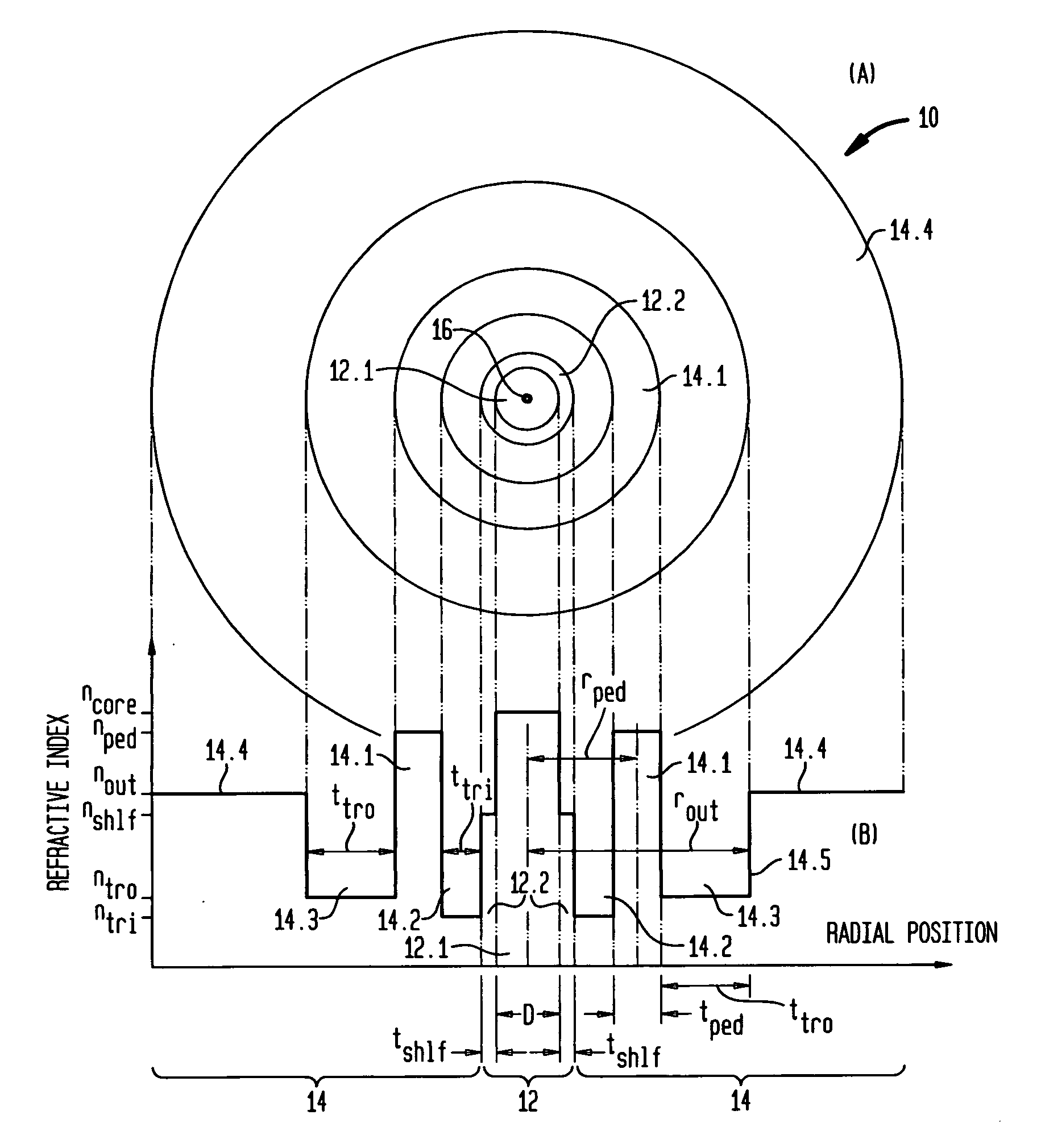Bend insensitivity in single mode optical fibers
a single-mode optical fiber and insensitivity technology, applied in the field of single-mode optical fibers, can solve the problems of inability to bend access fibers, inability to meet the fundamental transverse mode of a standard smf, and inability to meet the fundamental transverse mode of a standard smf, and achieve the effect of improving mode discrimination
- Summary
- Abstract
- Description
- Claims
- Application Information
AI Technical Summary
Benefits of technology
Problems solved by technology
Method used
Image
Examples
example i
[0075]In this example, the fiber preform had a diameter of 18.8 mm, and the drawn fibers had an outside diameter (OD) of either 119 μm or 125 μm. The various radial components had thickness / radius and index contrast (Δn) relative to the outer cladding region as listed below in Table I for the fiber having a 125 μm OD:
TABLE 1FIBER REGIONTHICKNESS (μm)RADIUS (μm)ΔnInner core4.90.005Shelf2.9−0.004Inner trench4.3−0.008Pedestal3.213.70.004Outer trench6.8−0.008Outer cladding220.000
[0076]The two fibers were characterized in terms of their cutoff wavelengths, bend loss (at a bend radius of 5 mm and at a wavelength of 1650 nm), and MFD (at a wavelength of 1550 nm), as indicated below in Table 2:
TABLE 2FIBER OD (μm)CUTOFF (nm)BEND LOSS (dB / m)MFD (μm)11914458.812515059.2
[0077]The 125-μm-OD fiber showed no impairment on preliminary CATV tests, despite the relatively high cutoff(1505 nm cutoff wavelength; 1553 nm signal wavelength).
[0078]The condition rbend>rcrit given by inequality (10) in this...
example ii
[0080]In this example, the fiber preform had a diameter of 19 mm, and the drawn fiber had an outside diameter (OD) of 125 μm. The various radial components had thickness / radius and index contrast (Δn) relative to the outer cladding region as listed below in Table 3:
TABLE 3FIBER REGIONTHICKNESS (μm)RADIUS (μm)ΔnInner core4.20.004Shelf1.6−0.001Inner trench5.7−0.005Pedestal2.312.70.003Outer trench7.1−0.005Outer cladding210.000
[0081]The fiber was characterized in terms of its cutoff wavelength, bend loss of 1 dB / m (at a bend radius of 6.25 mm and wavelength of 1550 nm), and MFD of 8.6 μm and 9.2 μm (at wavelengths 1310 nm and 1550 nm, respectively), as follows:
[0082]This fiber had a significantly lower cutoff of 1304 nm determined by ITU-2m measurement than either fiber of Example I. Some customers currently require a larger MFD and / or a cutoff<1260 nm, which can be attained by sacrificing bend loss. Example III below addresses such a fiber design.
[0083]At 1320 nm the fiber compares fav...
examples iii
, IV, V
[0087]This set of examples illustrates several different embodiments of our invention: Example III—a fiber having a dual-trench, ring design (akin to FIG. 1B) in which the inner and outer trench regions are both relatively deep and have essentially the same index depth; Example IV—a very high performance fiber having a dual-trench, ring design (akin to FIG. 1B) in which the inner and outer trench regions are both relatively deep but the inner trench region is deeper than the outer trench region; and Example V—a fiber having a dual trench, ring design (akin to FIG. 1C) in which the outer trench region is much shallower than the inner trench region. Examples III-V are defined more specifically by the index profile parameters shown in Table 4 below:
TABLE 4Ex.rcoreΔncoretshelfΔnshlfttriΔntritpedΔnpedttroΔntrorpedIII4.40.00392.2−0.00044.7−0.00572.60.00397.2−0.005712.6IV4.50.00412.3−0.00104.0−0.00973.00.00368.6−0.006012.3V4.60.00421.90.00009.2−0.00601.70.005112.1−0.000816.5
Fibers b...
PUM
 Login to View More
Login to View More Abstract
Description
Claims
Application Information
 Login to View More
Login to View More - R&D
- Intellectual Property
- Life Sciences
- Materials
- Tech Scout
- Unparalleled Data Quality
- Higher Quality Content
- 60% Fewer Hallucinations
Browse by: Latest US Patents, China's latest patents, Technical Efficacy Thesaurus, Application Domain, Technology Topic, Popular Technical Reports.
© 2025 PatSnap. All rights reserved.Legal|Privacy policy|Modern Slavery Act Transparency Statement|Sitemap|About US| Contact US: help@patsnap.com



